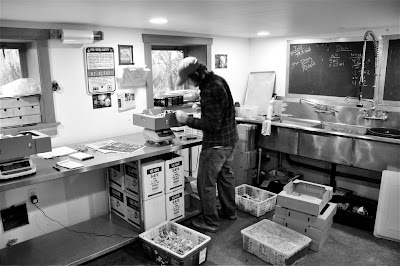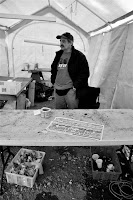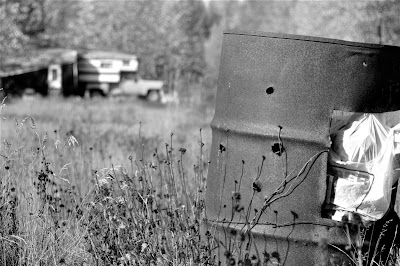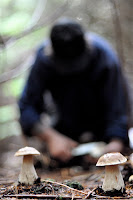My friend Beedle has been regaling me with tales of steelhead camp for as long as I can remember. A couple weeks ago I finally got to see it for myself.
After an 18-hour drive from Seattle, plus a few hours of winks in Prince George, we pulled into camp on the Kispiox River, tributary to the Skeena, near the small community of New Hazelton, British Columbia, and just a few clicks above the Kispiox Indian village. Most of the regulars were already in attendance, their tents pitched on a grassy bar above the river. There was a dentist and a former police chief, a fisheries biologist and a dot-com veteran, a furniture recycler and a professional chef, among others, most of them united by membership in the Northwest Atlantic Salmon Fly Guild. Everyone had another life to return to, but for now they were pilgrims paying their respects at steelhead mecca.
 Or maybe pleading at the wailing wall of anadromous fish. Even on the storied waters of the Skeena River system, where the steelhead are all wild and in relatively good numbers compared to their beleaguered cousins in Washington, Oregon, and California, the fishing ain’t easy, and I would discover this first-hand.
Or maybe pleading at the wailing wall of anadromous fish. Even on the storied waters of the Skeena River system, where the steelhead are all wild and in relatively good numbers compared to their beleaguered cousins in Washington, Oregon, and California, the fishing ain’t easy, and I would discover this first-hand.
Once the fish are in the system and they’ve run the gauntlet of ocean fisheries, bycatch, and in-river First Nations nets, the hopeful angler must worry above all about weather. This is north country and the weather changes its mind like the American electorate in a recession.
The Kispiox River looks more like a trout stream, with tannin-colored water, rocky ledges, and golden-hued poplars along its bank, yet it is the final destination for some of the biggest steelhead in the world, with record-breaking catches dating back to the 1950s, when reports of huge fish first leaked out to the angling public. Perhaps more enticing, this is one of the few rivers where a greaseliner can have a legitimate shot at a twenty-plus pound steelhead on a dry or “damp” fly, and for many of the anglers with whom I shared camp, the idea of using any other line besides a floating line was anathema.

But I would be casting my floating line on the Skeena for starters. The Kispiox, it turned out, was as low as it had ever been in 70 years of record-keeping. The river was gin clear and the fish ultra-spooky. So we headed for the Skeena, and in doing so encountered some of the classic double-speak (or no-speak) that is typical of the tight-lipped steelheader’s world. A conversation in camp might go like this:
“So where are you fishing tomorrow?”
Pause. “Skeena.”
“Skeena, huh? Well, it’s a little river.”
Little like the Columbia. But steelheaders are notoriously secretive and your best bet is to get them liquored up in camp, which I did the next night while serving my Morel Cream Sauce over steaks, thus prying a few flies out of one of our experienced camp mates. Small, drab, sparsely dressed, the flies he gave me looked more like trout flies. The next day on the Skeena I used one of them and discovered what all the fuss was about. I had on my floating line and a 12-foot leader tapered to 10-pound tippet. The tippet worried me but word was you needed long leaders and light lines to hook these fish in such low water conditions. I tied on one of my new flies and started swinging down through a tasty looking run of broken pocket water and boulders, casting a long line and swinging my fly probably no more than an inch or so beneath the surface. Just behind a rock the fish took.

It was on before my brain registered the fact, leaping in the air in an electric vibrating blast, as if trying to sprout wings on the spot: a huge hen with pink shining cheeks. She crashed back into the pool, shards of water catching the light, and broke for the middle of the river. I watched the line fly off my reel, wondering if the drag was set right and whether I’d have a bird’s nest on my hands in a second, and then, just before reaching my backing, she was gone. Poof, just like that. I reeled in to find the leader snapped at my tippet knot. My legs had the shakes.
Beedle also hooked into a nice Skeena hen, on a Thompson River Caddis fished in the film, and landed her after a good fight. The next day, with a light rain and the rivers rising, we fished the Kispiox, floating pontoons through some of the hallowed runs: the Potato Patch, Date Creek, the Powerline Hole, and the Gold Room. Below the Powerline Hole I landed this handsome buck.
It rained hard all night and we awoke to find…river out. All rivers out, from the Bulkley to the Kispiox to the Copper. Even the Skeena itself was too brown to fish, and rumor had it that anglers on the Dean River to the south were being evacuated by helicopter.
When forces beyond your control get the upper hand and bully you around, you feel utterly helpless. When life goes sideways or kittywampus, you can curse your misfortune in words that any steelheader will understand. River out!
So we spent a few days exploring the Skeena watershed and tuning into the local mushroom picking scene, which was going through its own river out due to the months-long drought and which no brief rain pulse was going to remedy anytime soon.
Amazingly, the Kispiox (“first to go out, last to come in”) actually came back into shape just before our departure, and I got one more crack at a colorful buck, which took me into my backing to the far side of the river and cartwheeled out of the water like a hen before I finally brought it to hand.
As with any pursuit, the detours and back roads are just as noteworthy as the destination. The time in camp telling stories and lies is the real gravy. And we were fortunate to have an old guard steelhead legend among us—his name will be familiar to serious steelheaders, Harry Lemire—sharing his tales of the old days (he quit fishing the Kispiox in ’71 because it was too crowded!), demonstrating fly-tying techniques, and generally being a gem of a guy with a quick wit and generous spirit.
You might wonder what all this has to do with wild foods and foraging. After all, steelhead on the Skeena system are strictly catch-and-release, as they should be to protect a resource that’s on the ropes throughout most of its range. My answer to that is that the forager’s life is ultimately about connecting with the natural world. Yes, food is a big part of that connection. Yet if you held a gun to my head and had me choose between eating wild foods or merely finding them, I would pick the latter. I love to eat, and learning my way around the kitchen will no doubt be an ongoing education, but it is the time in the outdoors that I cherish above all.
And so these great fish were returned to the river to complete their lifecycle—and perhaps to give some other lucky angler the tug of a lifetime.
Like this:
Like Loading...






















 Or maybe pleading at the wailing wall of anadromous fish. Even on the storied waters of the
Or maybe pleading at the wailing wall of anadromous fish. Even on the storied waters of the 

 But I would be casting my floating line on the Skeena for starters. The Kispiox, it turned out, was as low as it had ever been in 70 years of record-keeping. The river was gin clear and the fish ultra-spooky. So we headed for the Skeena, and in doing so encountered some of the classic double-speak (or no-speak) that is typical of the tight-lipped steelheader’s world. A conversation in camp might go like this:
But I would be casting my floating line on the Skeena for starters. The Kispiox, it turned out, was as low as it had ever been in 70 years of record-keeping. The river was gin clear and the fish ultra-spooky. So we headed for the Skeena, and in doing so encountered some of the classic double-speak (or no-speak) that is typical of the tight-lipped steelheader’s world. A conversation in camp might go like this:


























